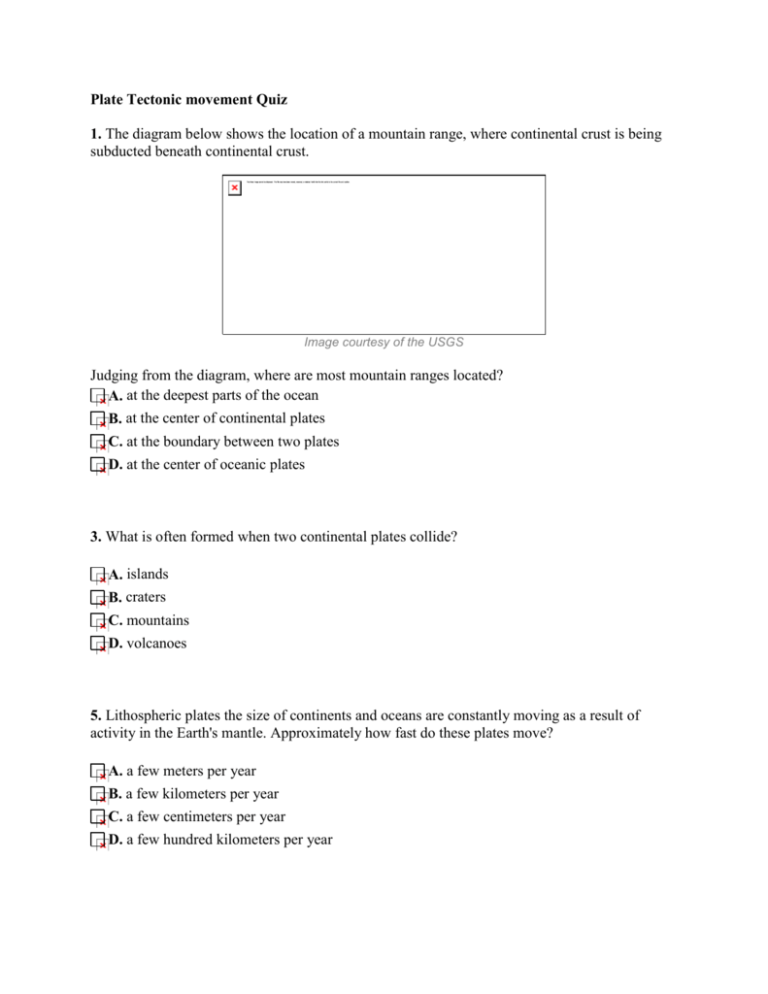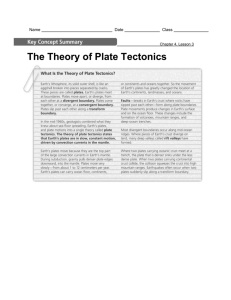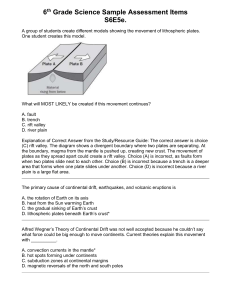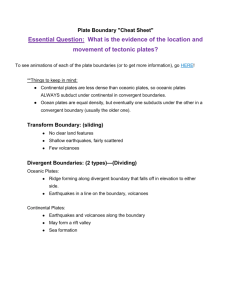Answers - MrTubb
advertisement

Plate Tectonic movement Quiz 1. The diagram below shows the location of a mountain range, where continental crust is being subducted beneath continental crust. Image courtesy of the USGS Judging from the diagram, where are most mountain ranges located? A. at the deepest parts of the ocean B. at the center of continental plates C. at the boundary between two plates D. at the center of oceanic plates 3. What is often formed when two continental plates collide? A. islands B. craters C. mountains D. volcanoes 5. Lithospheric plates the size of continents and oceans are constantly moving as a result of activity in the Earth's mantle. Approximately how fast do these plates move? A. a few meters per year B. a few kilometers per year C. a few centimeters per year D. a few hundred kilometers per year 8. The map below shows an area located near a lithospheric plate boundary. The red circles on the map show the locations of earthquakes. Knowing that lithospheric plate boundaries can be inferred from the locations of earthquakes, where is the plate boundary most likely located? The plate boundary runs north to south, through Green Oaks and Gardenville. A. B. C. D. The plate boundary runs east to west, through Gardenville and Meadowview. The plate boundary runs southwest to northeast, through Meadowview and Green Oaks. The plate boundary runs northwest to southeast, through Maple Grove and Gardenville. 9. Geologic evidence shows that Earth's lithospheric plates can move thousands of kilometers across the Earth's surface. These movements A. occur gradually over millions of years. B. occur due to human activity. C. do not change the Earth's surface at all. D. occur in one sudden movement. 11. How might two lithospheric plates interact with each other? I. They can collide with each other. II. One plate may slide under another plate. III. They can slide past each other. A. I and III only B. I and II only C. I, II, and III D. II and III only 12. The movement of the lithospheric plates changes the number of continents on Earth. This change would be seen over A. thousands of years. B. millions of years. C. centuries. D. decades. 13. The Earth is the only planet known to support life. Which of the following is a major contributing factor to the Earth's ability to support life? A. B. C. D. The Earth has a magnetic field with north and south poles. The Earth has an iron-rich core and is made mostly of rock. The Earth is surrounded by a layer of air that includes oxygen. The Earth orbits the Sun and is orbited by the Moon. 15. Earth's surface is constantly changing. Volcanoes erupt and form new crust. Lithospheric plate motions bend and crack old crust and cause earthquakes. Where do most of Earth's earthquakes and volcanoes occur? A. at the center of continental plates B. at the equator C. along hot spots in oceanic crust D. along plate boundaries 16. Earth's lithospheric plates A. move only up and down. B. move only once. C. are constantly in motion. D. do not move. Image courtesy USGS 17. The colors on the map above show the locations of the major lithospheric plates that make up the Earth's crust. Which city on the map is most likely to experience a major earthquake? A. Paris B. Juneau C. Rio de Janeiro D. New York 19. What causes events such as earthquakes, volcanic eruptions, and the creation of mountains? A. lithospheric plate movement B. position of the planets C. ocean tides D. atmospheric pressure 21. If old mountains wear down over the course of millions of years, what is one of the primary reasons that mountains still exist? A. B. C. New mountains are created through volcanic activity and lithospheric plate movement. New mountains are created from the erosion of rock and soil. New mountains are created as leaf litter builds up over millions of years. New mountains are created as a result of severe weather events, such as tornadoes and D. hurricanes. 25. The outer layer of the Earth—including both the continents and the ocean basins—is divided into separate plates. About how much do crustal plates move each year? A. 5-10 centimeters B. 5-10 meters C. 5-10 miles D. 5-10 kilometers 26. What is the term used to describe the area where thin oceanic plates spread apart, releasing magma and creating new oceanic crust? A. convergent boundary B. mid-ocean rift zone C. normal fault line D. subduction zone 27. Southern Italy is very close to the border of two lithospheric plates. Which of these facts is most directly related to the closeness of the plate boundary? A. The climate in Italy is warm and temperate. B. Italy has experienced many earthquakes. C. Many people like to vacation in Italy. D. Italy has many miles of coastline. 28. Which event below cannot be explained by the movement of the lithospheric plates? A. tornadoes B. volcanoes C. mountain formation D. earthquakes Answers 1. C 2. B 3. C 4. D 5. C 6. A 7. D 8. C 9. A 10. D 11. C 12. B 13. C 14. C 15. D 16. C 17. B 18. B 19. A 20. B 21. A 22. B 23. D 24. B 25. A 26. B 27. B 28. A 29. C 30. B









